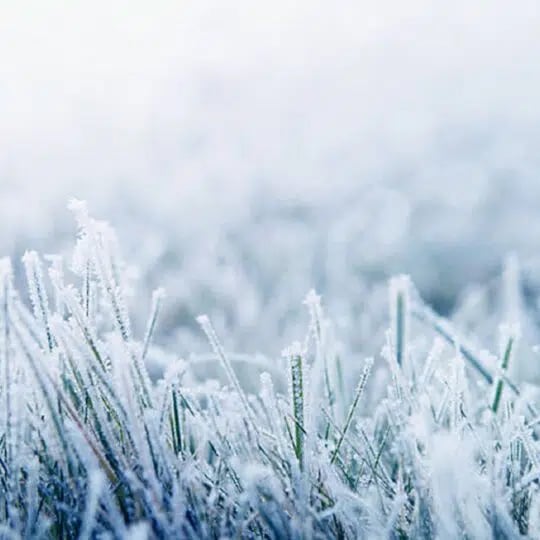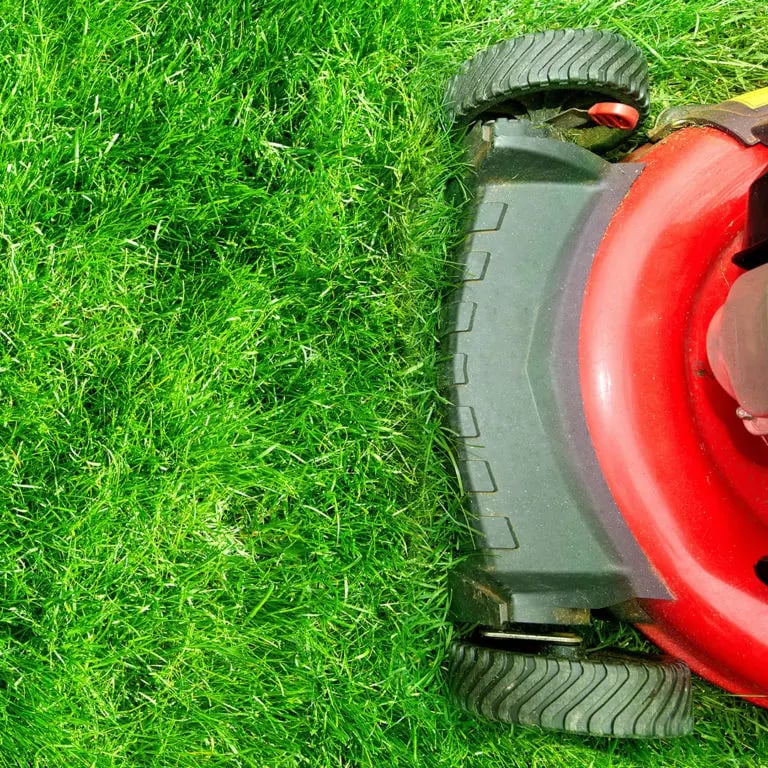Is it OK to Mow with Frost?

When the temperature falls below freezing, thin layers of ice form on the ground, grass, and other surfaces. The frost may be appealing to the eye but also a nuisance if your grass still needs one last mowing.
Frost and your lawn
Frost forms on your lawn when atmospheric conditions cause your grass to get colder than the surrounding air. In some extreme cases, heavy frost can cause significant damage to plants, including grass. And since water molecules expand during the freezing process, plant cells get damaged as the moisture expands and ruptures cell walls.
Depending on the grass species, a lawn could quickly give a noticeable sign of dying if it’s covered by heavy frost over several nights. What results is usually patchy grass with abnormal color in the affected areas. However, such types of damage are not necessarily irreparable.
The lawn’s roots are usually not affected, especially when the frost is mild. By staying above the freezing temperature, the lawn’s roots will generally have the ability to heal the cellular damage done to the grass as growth continues.
Frost can sometimes be beneficial to the grass on your lawn. For instance, your lawn develops a stronger root structure as it adapts to extreme cold conditions. As the cells in the grass get acclimated to very cold temperatures, they develop into tougher and “hardened” lawns, capable of withstanding severe temperatures.
Should you mow your lawn when it is covered with frost?
To keep your lawn healthy and to prevent doing serious damage to it, you should avoid mowing your lawn when it is frosted.

When the grass on your lawn is covered with frost and the soil’s moisture and grassroots have frozen, it’s best to completely avoid subjecting the grass to any form of pressure, such as mowing or walking. When the frost has gone into the ground, the frozen root region meets the unfrozen soil. Putting any kind of stress or pressure on the grass in such a condition could cause the frozen and unfrozen meeting points to continuously counteract each other in a process known as the “shearing effect”.
By subjecting the lawn to continuous pressure in that frozen state, the roots that lie in the unfrozen part of the soil will get severed, resulting in significant damage to the grass.
If you must mow your lawn during the frosty winter days, you need to ensure you carry out the mowing when the frost has melted and the temperatures have significantly risen. You can also quicken the process by using a sprinkler to melt the frost with warm water.
Minimizing the effect of frost on your lawn
One of the ways Green Lawn Fertilizing recommends preventing frost from covering your lawn is by ensuring you water it in the evening. Adequately watering your lawn enhances the evaporation of moisture through the night. The evaporation process produces some heat around the grass blades.
As the atmospheric temperature drops to its freezing point, the heat generated during the evaporation process helps the grass maintain a slightly higher temperature. This will prevent the formation of frost on your lawn, helping to protect your lawn from cellular damage.
If you live where frost is mild and infrequent, you may choose to mow your lawn during the winter to keep it in good condition. You, however, need to take extra care in order not to damage your grass and soil substrate when you mow in cold weather conditions.
Do not remove more than one-third of the total green blade length during any of your mowing sessions. This will help reduce the impact of the severely cold weather conditions on the grass.
Similarly, since the stress of cold weather puts lawns under constant strain and makes them susceptible to diseases, you must ensure your mower’s blade is well-sharpened and clean.
What is the ideal temperature to mow your grass?
Depending on the climate where you live and the species of your grass, the growth of your grass will either significantly slow down or go into dormancy during the cold winter months. You should never mow your lawn when temperatures are below freezing point or consistently below 40 degrees Fahrenheit.
To protect your grass, mow your lawn in warmer conditions. It’s best to wait until temperatures remain steady above 40 degrees for about 7 days or more.
For further assistance or questions, please contact us on social media or through our contact form!